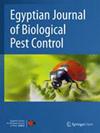Identification of native entomopathogenic fungi associated with Mahanarva fimbriolata Stahl in silvopastoral systems (Urochloa brizantha cv. MG-5 and Eucalyptus spp.)
IF 2.1
3区 农林科学
Q1 ENTOMOLOGY
引用次数: 0
Abstract
Abstract Background Pastures are susceptible to attacks from various species of insects, with Cercopidae being one of the main responsible pests. The species Mahanarva fimbriolata has a wide distribution in the Eastern region of Paraguay, leading to pasture damage. The most promising alternatives to chemical use are bioinsecticides, which could offer effective control while minimizing negative environmental impacts. Beauveria and Metarhizium have been documented as biocontrol fungi for Cercopidae insects. Therefore, identifying and isolating virulent native strains presents potential alternatives for controlling the spittlebug M. fimbriolata . Results Based on morphological and molecular characteristics, native strains of Metarhizium anisopliae and Beauveria bassiana were identified in the collected insects. Phylogenetic trees confirmed that the Beauveria sequence ( Beauveria seq) obtained in this study aligned with the ARSEF 842 isolate of B. bassiana . The Metarhizium sequence ( Metarhizium seq) was in the same clade as ARSEF 7450 and ARSEF 7487, which belong to the Metarhizium anisopliae . Beauveria bassiana displayed conidiophores that were broad at the basal part, forming synnemata or groups of conidiophores closely packed together, with a typical "zig-zag"-shaped rachis. The conidia were hyaline and smooth, ellipsoidal, and globose. On the other hand, M. anisopliae exhibited simple, straight conidiophores with bottle-shaped phialides. The conidia were elongated, ovoid to cylindrical, arranged in chains, and had an olive green color. Conclusions This is the first report of Metarhizium anisopliae and Beauveria bassiana obtained from nymphs and adults of Mahanarva fimbriolata in Paraguay.银栖系统中与毛卷Mahanarva fibriolata Stahl相关的本地昆虫病原真菌的鉴定(Urochloa brizantha cv.)。MG-5和桉树)
摘要背景牧草容易受到多种昆虫的侵害,其中尾蠓科是主要害虫之一。Mahanarva fibriolata在巴拉圭东部地区广泛分布,造成牧场破坏。最有希望的化学替代品是生物杀虫剂,它可以提供有效的控制,同时最大限度地减少对环境的负面影响。白僵菌和绿僵菌已被证明是蠓科昆虫的生物防治真菌。因此,鉴定和分离毒力强的本地菌株为控制毛状口沫虫提供了潜在的替代方法。结果根据形态和分子特征,鉴定出金龟子绿僵菌和球孢白僵菌的原生菌株。系统发育树证实,本研究获得的白僵菌序列(Beauveria seq)与球孢白僵菌ARSEF 842分离株一致。该绿僵菌序列(Metarhizium seq)与ARSEF 7450和ARSEF 7487属同一枝,均属于绿僵菌。球孢白僵菌的分生孢子基部较宽,形成紧密排列的分生孢子团或群,轴呈典型的“锯齿”形。分生孢子透明光滑,椭圆形,球状。另一方面,绿僵菌表现出简单、直的分生孢子和瓶状的分生孢子。分生孢子细长,卵形至圆柱形,链状排列,呈橄榄绿。结论在巴拉圭境内首次报道了从毛羽马蝇若虫和成虫中分离到金龟子绿僵菌和球孢白僵菌。
本文章由计算机程序翻译,如有差异,请以英文原文为准。
求助全文
约1分钟内获得全文
求助全文
来源期刊
CiteScore
4.90
自引率
16.70%
发文量
128
审稿时长
>12 weeks
期刊介绍:
The Egyptian Journal of Biological Pest Control is a periodic scientific journal published by the Egyptian Society for Biological Control of Pests (ESBCP) in collaboration with SpringerNature. The journal aims to publish internationally peer-reviewed, high-quality research articles in the field of biological and integrated pest control (non-chemical control). The journal publishes review articles, original papers, conference reports, book reviews, editorials, laboratory reports, technical notes and short communications.

 求助内容:
求助内容: 应助结果提醒方式:
应助结果提醒方式:


